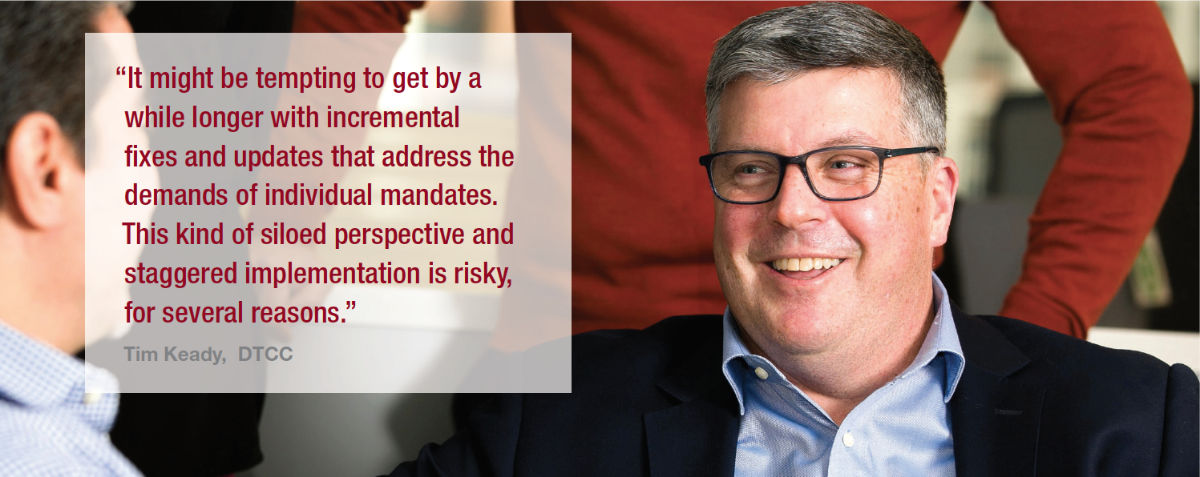
Rearchitecting your compliance framework.
Tim Keady, Managing Director, Head of DTCC Solutions and Chief Client Officer at DTCC.
Since the 2008 financial crisis the industry has confronted numerous waves of new and revised regulations with the compliance challenges that go along with them. And there’s more to come: headliners for the next two years include the push toward harmonising derivatives trade reporting standards across jurisdictions, the final phase-in of uncleared margin rules (UMR) and the start of CSDR’s Settlement Discipline Regime (SDR).
Combined with the thicket of rules already on the books – from Dodd-Frank to SFTR – the array of changing and emerging mandates are straining firms’ operations to a heightened degree. And when this infrastructure and related control framework is already a patchwork of functionalities from a decade of adapting to regulatory change, firms are facing important questions:
• When is the right time to upgrade my infrastructure and controls to manage compliance with all these regulations?
• Beyond timing, how do I tackle this burden in a way that’s manageable and cost efficient for my organisation?
• And, how do I ensure these upgrades will set my firm up more efficiently for future regulatory change and more-rigorous enforcement?
It’s like the situation confronting a homeowner 20 years after she moved in: the kitchen layout and appliances are out of date, the faucet’s leaking, and the family long ago outgrew the breakfast nook tucked into the corner. Incremental or DIY repairs may appear to be easy and cheap, but they may fail to pass inspection and only delay the inevitable full-blown renovation that’s required.
When it comes to firms’ reporting infrastructure, controls and processes, firms can choose to address the needed overhauls in a way that delivers the greatest value and readies them for the regulatory changes taking effect in 2021 and beyond.
A long to-do list
Mapping out the current and forthcoming regulations around transaction reporting, UMR and settlement discipline across multiple jurisdictions can make you dizzy. Regulatory moves, like the CFTC and SEC’s planned expansion and potential re-engineering of the trade reporting construct laid out in 2013, along with more rigorous requirements around liquidity management and settlement for UMR and CSDR respectively, promise to impose continuing changes to firms’ compliance strategies and responsibilities.
This regulatory landscape may be increasingly difficult to navigate using the processes, controls, governance and systems that have been built and repeatedly rejigged over the last 10 years. To keep pace with this churn firms are ripe for changes such as simplifying their data sets, becoming more sophisticated in sourcing key data elements related to collateral and unique identifiers, and either creating new or upgrading existing measures to mitigate settlement fails.
Like the leaky faucet, outdated appliances and ill-functioning kitchen layout, firms will need to deal with their cobbled-together infrastructure; there’s no way around it. But knowing what to do still doesn’t resolve how to do it.
My perspective
It might be tempting to get by a while longer with incremental fixes and updates that address the demands of individual mandates. This kind of siloed perspective and staggered implementation is risky, for several reasons.
First is the sheer volume of work on the plates of regulatory reporting teams in 2021 and 2022 and the need to stay ahead of compliance deadlines. Second is the likelihood of reporting and compliance overlap as jurisdictions move toward greater harmonisation across regulations, which could result in wasted effort if upgrades are handled piecemeal. Third are today’s tighter regulatory standards and more mature supervision, which can make DIY and incremental refits the riskiest and least cost-efficient approach over the long term.
The work ahead seems herculean but here’s another piece of advice: you don’t need to undertake the entire effort on your own. Through our new Consulting Services offering, DTCC provides deep, cross-functional experience and expertise to support you in making informed decisions and executing effective plans to help enhance your performance and assist you in reducing risks in your compliance operations.
DTCC Consulting Services offers end-to-end diagnostics, design, implementation and project management to help you design a fitting compliance program for your firm. For derivatives trade reporting, the program needs to account for new data fields, new products, new processes and controls, and new stakeholders. UMR requires heightened monitoring and control of liquidity and SDR more-efficient settlement processes. DTCC Consulting Services will help you make complex architectural decisions to enable you to operate your program and plan for its future scalability.
Rather than feeling overwhelmed by its enormity, I urge you to frame the task ahead as an opportunity to transform your legacy systems and processes for trade reporting, liquidity management and settlement – simplifying and rationalising them to suit the increased standardisation and harmonisation of global regulations, to aim for a scalable, efficient infrastructure that could lower your operating costs and risks.
©Markets Media Europe 2021
[divider_to_top]
©Markets Media Europe 2025























